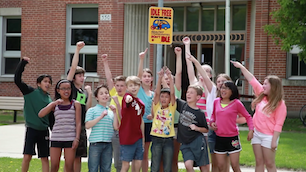 Make your school an idle-free zone.
Make your school an idle-free zone.
It’s easy. Simply contact Climate Change Connection to order your own Idle-Free Zone signs today and while you’re at it, if your school includes K-6, set up a day for us to come and speak to classes in your school.
Climate Change Connection will visit your school to talk about idling, safety, health, and climate change. We have presentations for early to middle years (K-6), and activities that will give students the opportunity to educate their parents about idling.
Your school will be part of a growing number of Winnipeg schools who are declaring their pick-up areas idle-free zones. There are currently over 200 signs posted at schools across the city, including all the schools in the St. James-Assiniboia and Seven Oaks School Divisions.
Make your school safer, cleaner and greener. Go idle-free!
Contact us to book a day for your school.
Idling at school
Look outside any school at the end of the day, and you may be greeted with this view: a line of buses and cars, idling as they wait for students. It doesn’t seem to matter that it isn’t cold out. Rain or shine, most vehicles have their engines running.
This is a bad habit for a number of reasons:
- Idling sends a confusing message to students about vehicle safety
- Idling affects local air quality
- Idling contributes to climate change
- Idling is a waste of money
Confusing message to students
Idling vehicles are standing still, but they can drive away at any time. Can children safely cross in front or behind an idling vehicle? Perhaps – but, if a vehicle’s engine is off, children know that the vehicle won’t start driving suddenly.
Not idling is one more easy step towards improving vehicle safety around schools.
Local air quality
In Stonewall, Manitoba, a concerned teacher described the school vestibule, “Between the doors was the overwhelming smell of exhaust. It was because of all the cars and buses idling just a few feet away in the parking lot”.
The level of exhaust in idling diesel school buses is as much as four times higher than in nearby vehicles. The air quality around buses, where students wait, is also poor. Idle-free zones ensure buses are turned off too.
Tailpipe emissions carry real health risks for children, who require more air per kilogram of body weight (inhaling a greater proportional volume of polluted air than adults would) and have lungs that are still developing and therefore more sensitive to irritants.
Students with asthma will breathe easier when vehicles aren’t idling. Ground-level ozone – a by-product of fossil fuel combustion — has been implicated as a bronchoconstrictor, causing airways to shrink or close, precipitating deadly asthma attacks.
Contributes to climate change
Exhaust from cars contains massive amounts of carbon dioxide (CO2) and nitrous oxide (NOx). Both of these are greenhouse gases which assist in enhancing the greenhouse effect. If every driver of a light-duty vehicle in Canada avoided idling for just five minutes, we would prevent more than 6,000 tonnes of CO2 from entering the atmosphere.
Waste of money
With fuel prices soaring, we should all be taking measures to conserve fuel, including not idling. Parents would save money twice over if they shut off their own engines, and if school buses did, too. School bus fleets – fuel included– are financed by the public pocketbook.
 Special thanks to Tire Stewardship Manitoba for supporting our Anti-Idling program.
Special thanks to Tire Stewardship Manitoba for supporting our Anti-Idling program.




